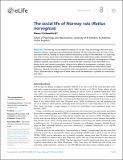Files in this item
The social life of Norway rats (Rattus norvegicus)
Item metadata
| dc.contributor.author | Schweinfurth, Manon Karin | |
| dc.date.accessioned | 2020-04-10T08:30:01Z | |
| dc.date.available | 2020-04-10T08:30:01Z | |
| dc.date.issued | 2020-04-09 | |
| dc.identifier | 267210622 | |
| dc.identifier | 999d8d72-b88f-4e94-b847-b8398d0ba743 | |
| dc.identifier | 85083239831 | |
| dc.identifier | 000526030600001 | |
| dc.identifier.citation | Schweinfurth , M K 2020 , ' The social life of Norway rats ( Rattus norvegicus ) ' , eLife , vol. 9 , e54020 . https://doi.org/10.7554/eLife.54020 | en |
| dc.identifier.issn | 2050-084X | |
| dc.identifier.uri | https://hdl.handle.net/10023/19778 | |
| dc.description | This work was supported by a grant of the Swiss National Science Foundation (grant number P2BEP3 175269). | en |
| dc.description.abstract | The Norway rat has important impacts on our life. They are amongst the most used research subjects, resulting in ground-breaking advances. At the same time, wild rats live in close association with us, leading to various adverse interactions. In face of this relevance, it is surprising how little is known about their natural behaviour. While recent laboratory studies revealed their complex social skills, little is known about their social behaviour in the wild. An integration of these different scientific approaches is crucial to understand their social life, which will enable us to design more valid research paradigms, develop more effective management strategies, and to provide better welfare standards. Hence, I first summarise the literature on their natural social behaviour. Second, I provide an overview of recent developments concerning their social cognition. Third, I illustrate why an integration of these areas would be beneficial to optimise our interactions with them. | |
| dc.format.extent | 26 | |
| dc.format.extent | 1553409 | |
| dc.language.iso | eng | |
| dc.relation.ispartof | eLife | en |
| dc.subject | BF Psychology | en |
| dc.subject.lcc | BF | en |
| dc.title | The social life of Norway rats (Rattus norvegicus) | en |
| dc.type | Journal item | en |
| dc.contributor.institution | University of St Andrews. School of Psychology and Neuroscience | en |
| dc.identifier.doi | 10.7554/eLife.54020 | |
| dc.description.status | Peer reviewed | en |
This item appears in the following Collection(s)
Items in the St Andrews Research Repository are protected by copyright, with all rights reserved, unless otherwise indicated.

